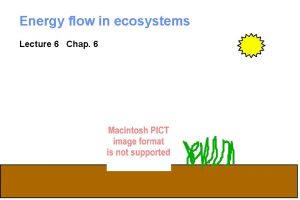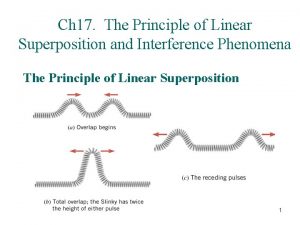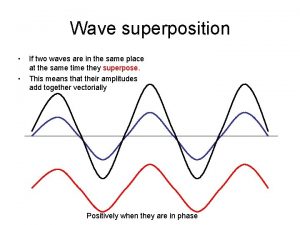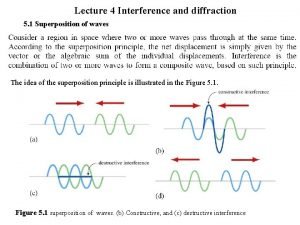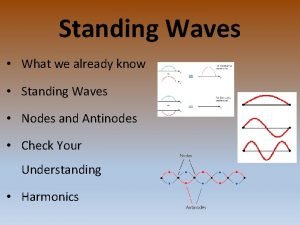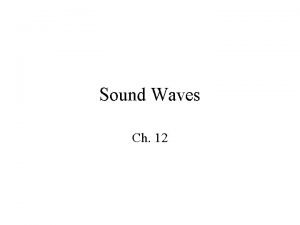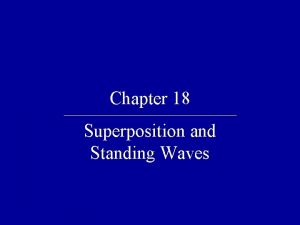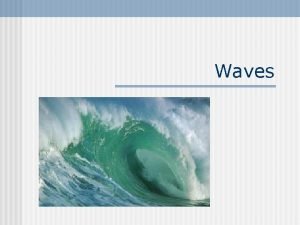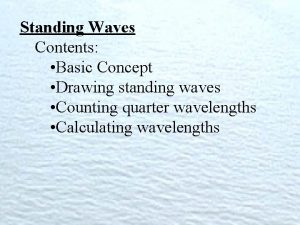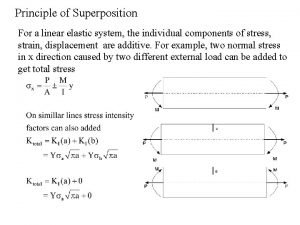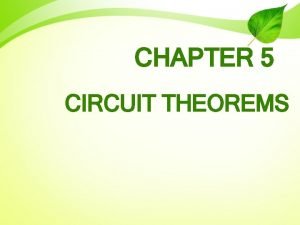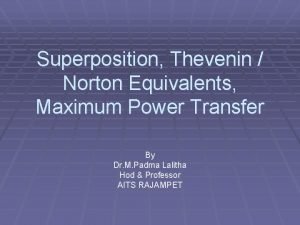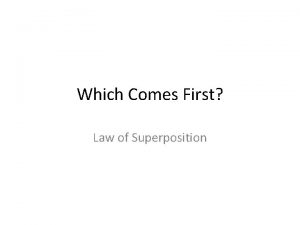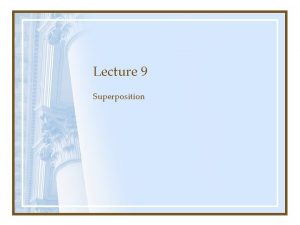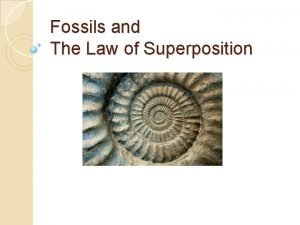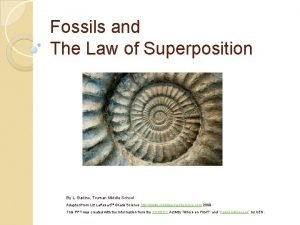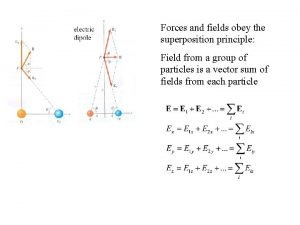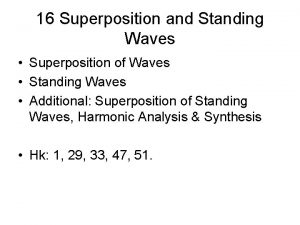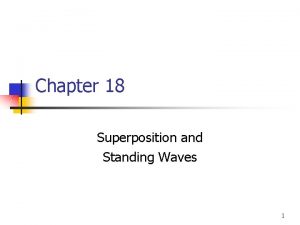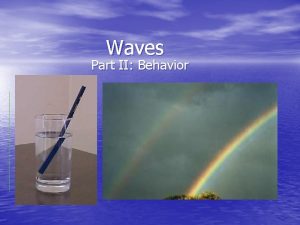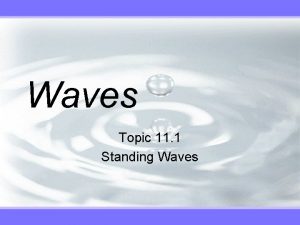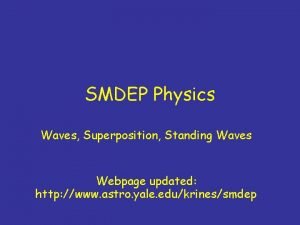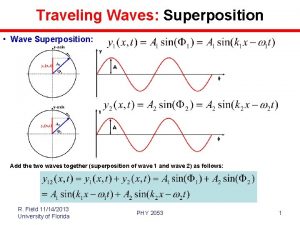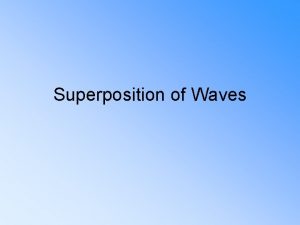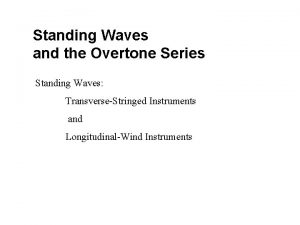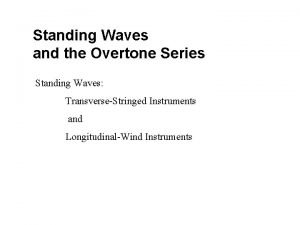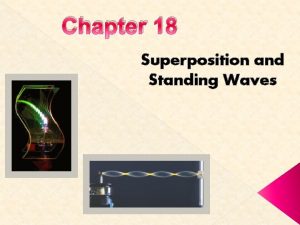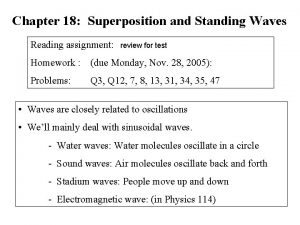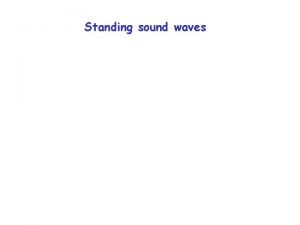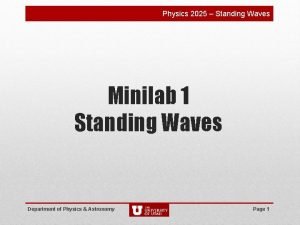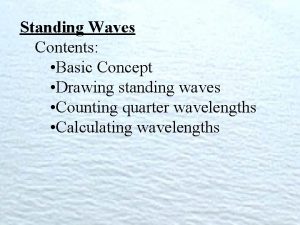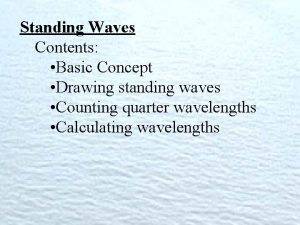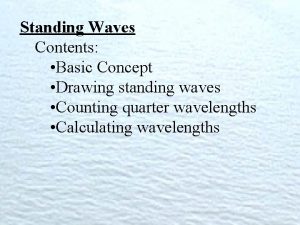Chapter 14 Superposition and Standing Waves Waves vs
































- Slides: 32

Chapter 14 Superposition and Standing Waves

Waves vs. Particles have zero size Waves have a characteristic size – their wavelength Multiple particles must exist at different locations Multiple waves can combine at one point in the same medium – they can be present at the same location 2

14. 1 Superposition Principle n n If two or more traveling waves are moving through a medium and combine at a given point, the resultant position of the element of the medium at that point is the sum of the positions due to the individual waves Waves that obey the superposition principle are linear waves n In general, linear waves have amplitudes much smaller than their wavelengths 3

Superposition Example n Two pulses are traveling in opposite directions n n n The wave function of the pulse moving to the right is y 1 and the one moving to the left is y 2 The pulses have the same speed but different shapes The displacements of the elements are positive for both 4

Superposition Example, cont n n When the waves start to overlap (b), the resultant wave function is y 1 + y 2 When crest meets crest (c ) the resultant wave has a larger amplitude than either of the original waves 5

Superposition Example, final n n n The two pulses separate They continue moving in their original directions The shapes of the pulses remain unchanged 6

Superposition in a Stretch Spring n n Two equal, symmetric pulses are traveling in opposite directions on a stretched spring They obey the superposition principle 7

Superposition and Interference n Two traveling waves can pass through each other without being destroyed or altered n n A consequence of the superposition principle The combination of separate waves in the same region of space to produce a resultant wave is called interference 8

Types of Interference n Constructive interference occurs when the displacements caused by the two pulses are in the same direction n n The amplitude of the resultant pulse is greater than either individual pulse Destructive interference occurs when the displacements caused by the two pulses are in opposite directions n The amplitude of the resultant pulse is less than either individual pulse 9

Destructive Interference Example n n n Two pulses traveling in opposite directions Their displacements are inverted with respect to each other When they overlap, their displacements partially cancel each other 10

14. 2 Superposition of Sinusoidal Waves n n n Assume two waves are traveling in the same direction, with the same frequency, wavelength and amplitude The waves differ in phase y 1 = A sin (kx - wt) y 2 = A sin (kx - wt + f) y = y 1+y 2 = 2 A cos (f/2) sin (kx - wt + f/2) 11

Superposition of Sinusoidal Waves, cont n n The resultant wave function, y, is also sinusoidal The resultant wave has the same frequency and wavelength as the original waves The amplitude of the resultant wave is 2 A cos (f/2) The phase of the resultant wave is f/2 12

Sinusoidal Waves with Constructive Interference n n When f = 0, then cos (f/2) = 1 The amplitude of the resultant wave is 2 A n n n The crests of one wave coincide with the crests of the other wave The waves are everywhere in phase The waves interfere constructively 13

Sinusoidal Waves with Destructive Interference n When f = p, then cos (f/2) = 0 n n The amplitude of the resultant wave is 0 n n Also any odd multiple of p Crests of one wave coincide with troughs of the other wave The waves interfere destructively 14

Sinusoidal Waves, General Interference n n When f is other than 0 or an even multiple of p, the amplitude of the resultant is between 0 and 2 A The wave functions still add 15

Sinusoidal Waves, Summary of Interference n Constructive interference occurs when f = np where n is 0 or an even integer n n Destructive interference occurs when f = np where n is an odd integer n n Amplitude of the resultant is 2 A Amplitude is 0 General interference occurs when 0<f<p n Amplitude is 0 < Aresultant < 2 A 16

Interference in Sound Waves n n n Sound from S can reach R by two different paths The upper path can be varied Whenever Dr = |r 2 – r 1| = nl (n = 0, 1, …), constructive interference occurs 17

Interference in Sound Waves, cont n n n Whenever Dr = |r 2 – r 1| = (n/2)l (n is odd), destructive interference occurs A phase difference may arise between two waves generated by the same source when they travel along paths of unequal lengths In general, the path difference can be expressed in terms of the phase angle 18

19

20

21

14. 3 Standing Waves n n n Assume two waves with the same amplitude, frequency and wavelength, travel in opposite directions in a medium y 1 = A sin (kx – wt) and y 2 = A sin (kx + wt) They interfere according to the superposition principle 22

Standing Waves, cont n n The resultant wave will be y = (2 A sin kx) cos wt This represents the wave function of a standing wave n n There is no function of kx – wt, and therefore it is not a traveling wave Every elements of the medium vibrate in simple harmonic motion with the same angular frequency w. The amplitude of the motion of a given element depends on its position along the medium. The envelope function of the amplitude is 2 A sin(kx). 23

Note on Amplitudes n There are three types of amplitudes used in describing waves n n n The amplitude of the individual waves, A The amplitude of the simple harmonic motion of the elements in the medium, 2 A sin kx The amplitude of the standing wave, 2 A n A given element in a standing wave vibrates within the constraints of the envelope function 2 Asin kx, where x is the position of the element in the medium 24

Standing Waves, Particle Motion n n Every element in the medium oscillates in simple harmonic motion with the same frequency, w However, the amplitude of the simple harmonic motion depends on the location of the element within the medium n The amplitude will be 2 A sin kx 25

Standing Waves, Definitions n A node occurs at a point of zero amplitude n n These correspond to positions of x where An antinode occurs at a point of maximum displacement, 2 A n These correspond to positions of x where 26

Nodes and Antinodes, Photo 27

Features of Nodes and Antinodes n n n The distance between adjacent antinodes is l/2 The distance between adjacent nodes is l/2 The distance between a node and an adjacent antinode is l/4 28

Nodes and Antinodes, cont n n The standing-wave patterns at various times produced by two waves of equal amplitude traveling in opposite directions In a standing wave, the elements of the medium alternate between the extremes shown in (a) and (c) 29

30

31

32
 Difference between standing crop and standing state
Difference between standing crop and standing state Principle of linear superposition
Principle of linear superposition Principle of superposition waves
Principle of superposition waves Superposition of waves
Superposition of waves Node and anti node
Node and anti node Standing wave
Standing wave Sonic spectrum definition
Sonic spectrum definition Standing waves quiz
Standing waves quiz Standing waves
Standing waves Draw a picture of standing waves with n=3
Draw a picture of standing waves with n=3 Compare and contrast p waves and s waves using venn diagram
Compare and contrast p waves and s waves using venn diagram High and low frequency waves
High and low frequency waves A matter in which waves can travel and transfer energy
A matter in which waves can travel and transfer energy Difference between electromagnetic waves and sound waves
Difference between electromagnetic waves and sound waves Long waves and short waves
Long waves and short waves Difference between matter waves and electromagnetic waves
Difference between matter waves and electromagnetic waves Mechanical waves and electromagnetic waves similarities
Mechanical waves and electromagnetic waves similarities Surface waves and body waves
Surface waves and body waves Mechanical waves and electromagnetic waves
Mechanical waves and electromagnetic waves What are constructive waves
What are constructive waves Principle of superposition in stress and strain
Principle of superposition in stress and strain Circuit theorem
Circuit theorem Difference between superposition and thevenin theorem
Difference between superposition and thevenin theorem Longitudinal wave vs transverse wave
Longitudinal wave vs transverse wave The wave chapter 13
The wave chapter 13 Sound waves longitudinal waves
Sound waves longitudinal waves Electromagnetic waves vs mechanical waves
Electromagnetic waves vs mechanical waves Seismic waves are mechanical waves
Seismic waves are mechanical waves What is the law of superposition
What is the law of superposition Superposition theorem examples
Superposition theorem examples Arrange the cards
Arrange the cards Superposition in fossils
Superposition in fossils Superposition principle
Superposition principle
